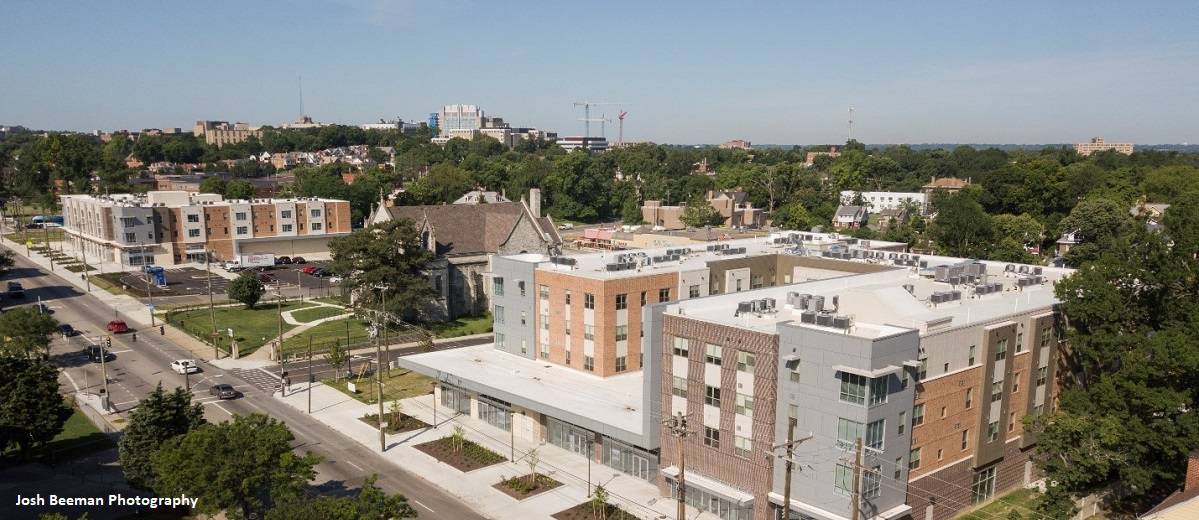For years the predominantly Black neighborhood of Avondale in Cincinnati has seen a dramatic disinvestment that left the community with underutilized and unsafe amenities like Avondale Town Center, a suburban style retail strip with neither a walkable neighborhood center nor quality retail options. The city-owned Town Center site was originally developed in 1983 and quickly became a symbol of decline for a community that struggled to attract the assets or amenities residents wanted.
In 2012, a profound change began when the community implemented a comprehensive revitalization plan for the neighborhood including the redevelopment of Avondale Town Center. The plan was rooted in affordable housing, with an intentional focus to incorporate commercial and retail tenants that deliver critical services and amenities to the neighborhood. Today, the Town Center has become an essential core of the neighborhood with services, amenities, local business development and vibrant public art.
The Community Builders (TCB), a nonprofit affordable housing developer and Stewards of Affordable Housing for the Future (SAHF) member organization, was a key partner in the revitalization plan. TCB had to leverage a slew of federal and local public funding sources, including the Low Income Housing Tax Credit, New Markets Tax Credit, Capital Magnet Fund, HUD CHOICE Neighborhoods Grant Funds, Healthy Foods Financing Initiative, City of Cincinnati resources, and more. TCB also secured a flexible “Equity With a Twist” loan from LIIF, which allowed TCB to fill financing gaps with debt that mimics the flexibility of equity.
Thanks to the community’s vision for its neighborhood and the technical expertise and resources provided by groups like TCB and LIIF, Avondale Town Center is on a path to a more prosperous future. Yet there remain too many communities across the country where the herculean effort of leveraging numerous funding sources and building local capacity is simply not possible given scarce resources and compounding inequities. The time and resources it took just to assemble the capital to get the Avondale project off the ground could be much better spent supporting other neighborhoods to build their own vision for a more equitable, sustainable future.
That’s why we are so encouraged by the Biden-Harris administration’s proposal to create a new $10 billion HUD grant program explicitly intended to invest in civic infrastructure. As part of the administration’s Build Back Better agenda, President Biden proposed creating a new Community Revitalization Fund to support community-led redevelopment projects that create innovative shared amenities, spark new local economic activity, provide services, build community wealth, and strengthen social cohesion.
LIIF and TCB recently joined 97 organizations on a letter to congress in support of the Community Revitalization Fund. The letter recommends that the Community Revitalization Fund be prioritized as a complement to the more than $300 billion in proposed affordable housing investments currently proposed. This is based on several decades of experience in which we have learned that building affordable housing connected to civic infrastructure is the most effective and sustainable method to increase resident opportunity and well-being.
This lesson is in part why the investments in Avondale Town Center were successful. The redevelopment began with a focus on new multifamily housing and mixed-use construction to serve as an anchor of stability and opportunity. From there, new commercial and retail tenants were brought to the neighborhood, including the first laundromat in the community, a Federally Qualified Health Center, a market with access to fresh, healthy food options, and the community’s first sit down restaurant in more than a decade. The initiative also created a three-square-mile Wi-Fi hotspot covering much of Avondale. In total, 15 new or preserved businesses are under lease at Avondale Town Center, the majority of which are local and Black-owned, fulfilling a fundamental community objective.
Just as TCB and LIIF helped the community achieve its vision for Avondale, CDFIs and non-profit affordable housing developers will be critical partners to HUD in the implementation of the Community Revitalization Fund. We bring a deep commitment to racial and economic justice, and in many communities have developed powerful partnerships with organizations and individuals rooted in the fabric of the community. We also have decades of experience working with complex funding sources, which helps stretch the impact of each federal dollar invested. By blending public and private capital, CDFIs and non-profit affordable housing developers can both help communities achieve their transformative vision while also ensuring community assets are structured and supported for long-term sustainability.
The redevelopment of the Avondale Town Center into a vibrant mixed-income, mixed-use development represents a creative way that cities can reposition vacant and underutilized strip retail centers into thriving neighborhood cores that serve the entire community. The Community Revitalization Fund is the kind of game-changing proposal that could accelerate this work. Congress should prioritize the Community Revitalization Fund as an essential element of its once-in-a-generation social spending investment.
For more information about The Community Builders and/or the redevelopment of Avondale Town Center, contact Jeff Beam, Regional Vice President for Real Estate Development. For more information about the Community Revitalization Fund and/or LIIF’s policy advocacy, contact LIIF’s Policy Team.
